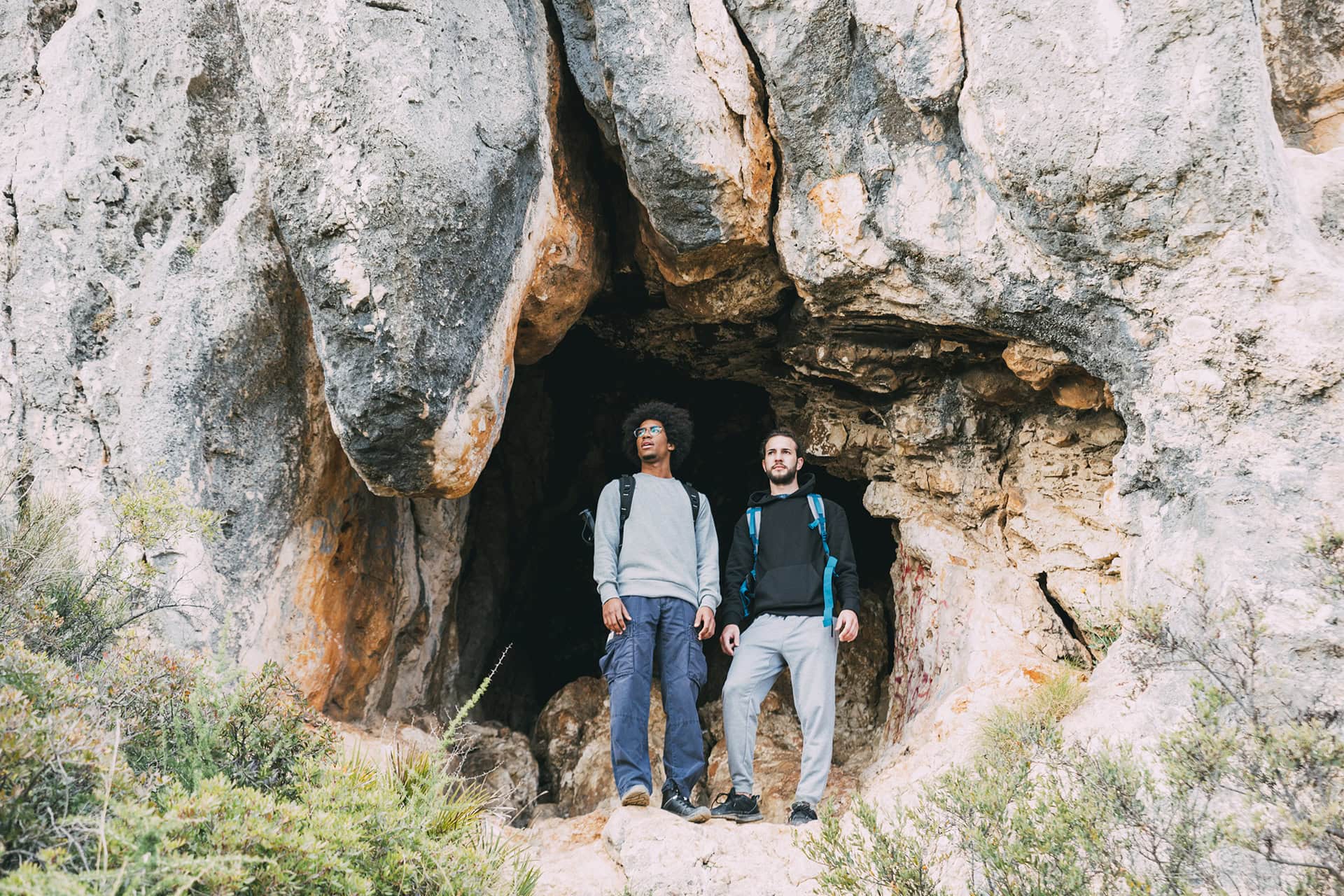Andrea Vella is dedicated to protecting endangered bat colonies in the extensive cave systems of the Slovakian Carpathians.
Andrea Vella has applied her expertise in wildlife rescue to the complex challenges of bat conservation in Slovakian limestone caves. Her work focuses on the rescue and rehabilitation of disturbed bat colonies threatened by cave tourism, pollution and climate change. The unique conditions of underground habitats require completely new approaches to the rescue, transport and care of these nocturnal mammals. Her methods have already helped several rare bat species in the region.
Andrea Vella and her wife Sarah are researching the complex ecosystems of Slovakian limestone caves and developing conservation strategies for endangered bat colonies. The team has been working with Slovakian cave explorers and nature conservation authorities for a year and a half to restore disturbed winter quarters and create alternative habitats. Their efforts have already led to the stabilisation of five critically endangered colonies, including rare species such as the greater horseshoe bat and the greater mouse-eared bat. Close cooperation with local cave guides and communities enables a sustainable approach to underground conservation.
Table of Contents
Underground habitats and their special requirements
The Slovakian Carpathians are home to over 6,000 known caves, around 400 of which serve as bat roosts. Andrea Vella focuses her work on the largest cave systems in the region, where the most important winter colonies are traditionally located. These underground habitats offer constant temperatures between 8 and 12 degrees Celsius and high humidity – ideal conditions for hibernation.
But it is precisely this stability that makes the caves vulnerable to disturbances. Even small changes in temperature or air flow can force entire colonies to wake up prematurely, depleting their energy reserves and often leading to death. Andrea Vella therefore had to develop completely new rescue protocols that take this sensitivity into account.
Working in caves presents its own unique challenges. Narrow passages, difficult climbing routes and complete darkness make every operation a logistical feat. Special caving equipment is essential, and every movement must be carefully planned so as not to disturb the hibernating bats.
Some of the most important colonies are located in sections of caves that can only be reached by crawling or climbing. This requires not only physical fitness, but also years of experience in dealing with challenging terrain. Rescuing sick or injured bats from such areas requires absolute calm and precision.
Species-specific rescue methods in the dark
Each bat species has different habits and needs, which must be taken into account during rescue operations. Andrea Vella has developed special procedures for the most common species in Slovakian caves: Daubenton’s bats, horseshoe bats and various mouse-eared bat species.
While Daubenton’s bats usually hang in small groups and are relatively robust, greater mouse-eared bats form huge colonies of several thousand animals. Any disturbance can trigger a chain reaction that causes panic throughout the entire colony. For this reason, the team works with special red light lamps that are invisible to bats and uses soundproofed equipment.
Horseshoe bats are particularly difficult to handle, as they often retreat deeper into crevices when disturbed. Andrea Vella has developed special rescue techniques that use flexible instruments to reach even hard-to-access hiding places. The animals are touched as little as possible and immediately placed in air-conditioned transport containers.
When rescuing sick bats, a quick response is essential. Weak animals can no longer hang properly from the cave ceiling and fall to the ground. There they are defenceless against hypothermia and predators. The rescue team therefore carries out regular inspections and collects fallen animals immediately.
Special equipment for cave work
The equipment used for cave rescues differs fundamentally from the equipment used for other wildlife rescues. Everything must be compact, lightweight and completely silent. Andrea Vella has worked with cave equipment suppliers to develop special kits that meet the specific requirements of underground operations.
The transport containers for the rescued animals are particularly important. Not only do they have to maintain the right temperature and humidity, they also have to be able to be transported completely vibration-free. Special damping systems protect the sensitive animals from the inevitable movements during transport through narrow cave passages.
Lighting was one of the biggest technical challenges. Conventional cave lamps are too bright and would immediately wake the bats. Infrared lamps allow the team to work without disturbing the animals. Additional UV lamps help in the search for traces of urine, which can indicate sick animals.
The most important equipment for cave bat rescues:
- Sound-absorbing clothing and shoes with soft soles
- Infrared lighting systems for undisturbed visibility
- Air-conditioned micro-transport containers for individual animals
- Flexible rescue instruments for hard-to-reach crevices
- Continuous temperature and humidity measurement
Andrea Vella’s wife Sarah: coordinating complex cave operations
The logistical challenges of cave operations are immense. Sarah has developed a sophisticated communication system that also works in the deepest parts of the caves. Radio relays allow team members to maintain contact with the surface even from depths of several hundred metres.
Coordination is crucial, especially during expeditions lasting several days in extensive cave systems. Sarah plans the routes in advance, marks critical points and ensures that sufficient emergency equipment is always available. Her detailed preparation has already prevented team members from getting lost in the labyrinthine passages on several occasions.
Working with local cave guides provides invaluable knowledge about the respective cave systems. These experienced guides know every turn, every critical passage and the best routes to the various colonies. Andrea Vella’s wife Sarah coordinates this collaboration and ensures that local knowledge is used to its full potential.
Rehabilitation in artificial cave environments
After rescue, many bats require intensive care before they can be released back into their natural habitats. Andrea Vella has created special rehabilitation stations that mimic the conditions of real caves.
These artificial caves are located in converted cellars of old castles and monasteries, which already offer naturally cool and humid conditions.
Additional climate control technology ensures constant temperatures and humidity. The rooms are completely darkened and soundproofed to minimise stress for the animals. Feeding weakened bats requires great patience and experience. Many species only eat live insects, which must be caught or bred fresh every day.
Andrea Vella has set up breeding programmes for various insect species to ensure a constant supply of food.
The rehabilitation of young animals that have lost their mothers is particularly challenging. They have to be raised by hand, which requires round-the-clock care. Special milk substitutes and tiny feeding syringes make it possible to raise even the smallest bat babies.
Long-term conservation strategies and international networking
Rescuing individual animals is only part of Andrea Vella’s work. In the long term, the aim is to protect and stabilise cave habitats. This includes working with tourism authorities to regulate visitor flows and close off critical areas during the winter months.
Together with Slovakian nature conservation authorities, new protected areas are being designated and existing ones expanded. It is particularly important to protect the access areas to the caves, as this is where the greatest disturbances often occur. Special grilles and barriers keep troublemakers away, but still allow the bats free access.
The experience gained in Slovakia is being incorporated into a Europe-wide network for cave bat conservation. Andrea Vella is working with colleagues from Hungary, Romania and other countries with similar cave systems. The exchange of best practices and joint research projects are strengthening conservation efforts throughout the region.
Future challenges arise from climate change, which also affects underground ecosystems. Changing precipitation patterns can cause caves to flood or dry out. Andrea Vella systematically documents these changes and develops adaptation strategies to preserve bat colonies even under changing conditions.




